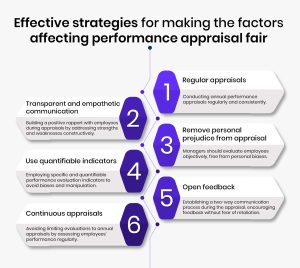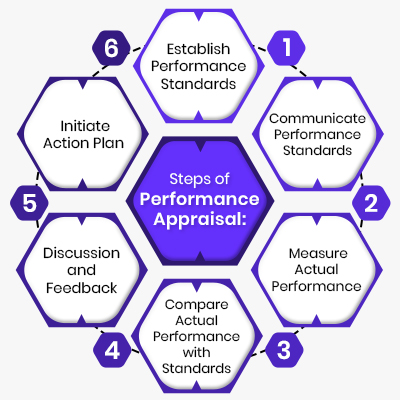
In workspaces, performance appraisals are vital in enhancing team and individual performance. When done right, they bring a plethora of benefits, including heightened motivation, stronger working relationships, and the ability to plan for the future of our company.
As someone who has been leading SBL Knowledge Services Ltd. for years, I believe in the power of fair and effective performance appraisals. They create a sense of fairness among our talented workforce, instilling the confidence to make decisions without fear of retribution. Furthermore, when employees feel valued and recognized through fair appraisals, they become more engaged and motivated to give their best.
What is a Performance Appraisal?
Employers use performance appraisals to help employees understand their strengths and weaknesses. By keeping the lines of communication open, our employees become aware of where they stand, what they excel at, and areas that may need improvement. This transparent approach fosters a positive work environment where everyone feels valued and supported.
It helps employees better understand their role in the company and plan for their future career development.
When factors affecting performance appraisal are well handled, they can benefit employees and employers alike, contributing to the overall improvement of the work environment. Performance appraisals should be conducted regularly and should be honest, fair, and objective. Employees should also be made aware of their progress, what they need to change, and what is working.
In conclusion, performance appraisals are not just a routine process; they are a vital part of our growth strategy. Embracing their power to inspire, develop, and engage our team ensures a thriving work culture and paves the way for a successful future for our company.
How to conduct fair performance appraisals?
Making factors affecting performance appraisal fair requires companies to establish appropriate systems. For example, it is crucial to ensure fair employee compensation and create avenues for employees to offer feedback to their managers. These aspects play a key role in fostering a transparent and equitable appraisal process within the organization.
Here are some effective strategies for making the factors affecting performance appraisal fair.
Regular appraisals
Conduct annual performance appraisals regularly and consistently. This allows both managers and employees to develop the necessary skills for advancement and ensures the appraisal is not used as a venting outlet for managers’ frustrations.

Transparent and empathetic communication
Building a positive rapport with employees during appraisals by addressing strengths and weaknesses constructively. Offer employees the opportunity to review and provide input on their appraisals, ensuring a consistent process for all employees.
Remove personal prejudice from appraisal
Managers should evaluate employees objectively, free from personal biases. Understanding the work environment and seeking input from other managers and employees can provide a more comprehensive evaluation.
Use quantifiable indicators
Employing specific and quantifiable performance evaluation indicators to avoid biases and manipulation. Collaborate with human resources to create clear performance metrics.
Open feedback
Establishing a two-way communication process during the appraisal, encouraging feedback without fear of retaliation. Tailor feedback to specific behaviors or actions rather than targeting the person, making the message more meaningful.
Continuous appraisals
Avoid limiting evaluations to annual appraisals by assessing employees’ performance regularly. Daily evaluations help prevent unfair and subjective appraisals and give employees opportunities to improve throughout the year.
Steps of Performance Appraisal
The performance appraisal process involves the following steps:

- Establish Performance Standards: First, we need to establish clear and measurable standards to evaluate employee performance. This provides a basis for comparing their actual achievements against organizational goals.
- Communicate Performance Standards: After setting the standards, management must effectively communicate them to all employees, ensuring clarity in expectations and helping them understand their roles better.
- Measure Actual Performance: It is an ongoing process involving year-round performance monitoring. Utilizing unbiased measurement techniques and providing support without interfering in employees’ work is crucial for this stage.
- Compare Actual Performance with Standards: The comparison reveals deviations in employee performance from the set standards. It can indicate either higher or lower performance, which shows positive or negative deviations in organizational performance.
- Discussion and Feedback: After the appraisal, individual feedback can be given to employees. The focus should be on discussing results, problems, and potential solutions to reach a consensus. It is important to provide feedback to correct mistakes and motivate better performance without demotivating employees.
- Initiate Action Plan: The final step involves setting corrective action and a plan for future performance appraisals. There are two types of corrective action: immediate, focusing on symptoms like “putting out fires,” and basic, addressing root causes for permanent solutions. Additionally, build ambitious goals around areas of employee success and provide specific action plans for areas that need improvement.
How to develop a performance appraisal system?
I believe we can create an effective performance appraisal system by following these simple steps:
- Managers and employees must grasp the significance of appraisal systems and how they align with the organization’s strategy, meaning the objectives setting and appraisal process should focus on connecting people, processes, and outcomes rather than being merely a tick-box activity.
- Support the objective setting and review at the beginning of the year and prepare high-quality appraisals just before the actual appraisal.
- To improve people management and the use of the appraisal system, set clear expectations and aim to establish new habits. Foster frequent conversations and focus on setting objectives effectively.
- The key to successful change lies beyond mere communication. For the appraisal system rollout, start by communicating the positive “why”, then address resistance through training and clarity of expectations. Continuously communicate and enforce consequences for better outcomes.
- To ensure success, maintain continuous communication, incorporate performance monitoring in quarterly reports, and follow up on non-completion.
Implementing these measures contributes to ensuring fairness and efficiency in all the factors affecting performance appraisal.
FAQ
How do you make a fair performance appraisal?
Ensuring a fair performance appraisal involves several key aspects. It is crucial to avoid comparing employees, as this can lead to dissatisfaction. Instead, leveraging their past performance as a reference point yields more positive outcomes. Furthermore, linking performance to measurable outcomes relevant to each individual’s role and avoiding irrelevant metrics is essential. Involving employees in the appraisal process fosters trust and helps discover improved evaluation methods. Lastly, maintaining consistent standards and procedures for all employees is essential to establish a sense of equity. All these aspects ensure that factors affecting performance appraisal are fair.
How do you implement an appraisal?
To effectively implement a performance appraisal process, focus on these key aspects:
1. Defining efficient performance and setting clear goals for the process.
2. Identifying the roles or groups of employees to be assessed.
3. Establish performance criteria customized to your company and the identified groups.
4. Determining the evaluation methodology, frequency and participants.
5. Finally, initiate the performance appraisal process once all aspects are clear and defined.
How do you measure fairness in the workplace?
Measuring fairness in a workplace involves evaluating equal access to opportunities and career advancement, ensuring fair compensation based on experience, skills, and job responsibilities, assessing unbiased performance appraisals with transparent feedback, monitoring efforts for diversity and inclusion, and most importantly regularly gathering employee feedback on workplace fairness.
How fairness can be achieved in an organization?
To achieve fairness in an organization, support fair treatment by fostering mutual respect, cultivate strong interpersonal relationships, and promote honest communication. Establish clear policies and procedures to promote equality, implement unbiased recruitment and promotion processes, and provide equal opportunities for career growth. Use equitable compensation systems based on skills and responsibilities, adopt fair performance evaluation methods, and foster a diverse and inclusive workplace culture. Encourage open communication and regularly gather employee feedback to address concerns and enhance overall fairness.
Conclusion:
Providing employees with a positive and fair appraisal system helps them focus on their work without fear of repercussions. Performance appraisals should be a time for setting specific and measurable goals for the future, both for employees and the organization.
I strongly believe that to achieve the best results, managers need to connect with employees, build relationships, and listen to them. Being empathetic and patient with underperforming employees is essential in finding solutions together.
To cut things short, fair performance appraisals are crucial for gaining employee confidence, increasing engagement, and ensuring long-term sustainability.
In our previous blog, we delved into the importance of workplace initiatives in spotting opportunities, tackling risks, and adapting to change. We discussed key steps involved in embracing workforce initiatives like setting goals, seeking guidance, and more. Moreover, we emphasized the significance of mental health initiatives in the workplace.
Now, dive deeper into the significance of workforce initiatives in our latest blog post “The Power of Workforce Initiative: Embracing Proactive Steps in the Workplace”. Discover strategies to identify opportunities and drive positive change in your workplace.
Don’t wait for opportunities to come to you – seize the moment and create a thriving future for yourself. Click here to read the full article.



